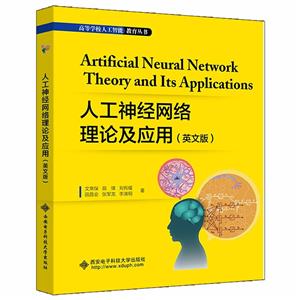-
>
中医基础理论
-
>
高校军事课教程
-
>
毛泽东思想和中国特色社会主义理论体系概论(2021年版)
-
>
中医内科学·全国中医药行业高等教育“十四五”规划教材
-
>
中医诊断学--新世纪第五版
-
>
中药学·全国中医药行业高等教育“十四五”规划教材
-
>
中医外科学——全国中医药行业高等教育“十四五”规划教材
人工神经网络理论及应用(英文版) 版权信息
- ISBN:9787560660356
- 条形码:9787560660356 ; 978-7-5606-6035-6
- 装帧:一般胶版纸
- 册数:暂无
- 重量:暂无
- 所属分类:>>
人工神经网络理论及应用(英文版) 本书特色
本书较全面地介绍了人工神经网络的相关理论及应用。全书包含三篇:人工神经网络基础、人工神经网络理论和人工神经网络实际应用。**篇包括生物神经网络理论基础、人工神经网络概述、人工神经网络数理基础。第二篇包括一些人工神经网络理论和几何概念,如感知器、BP神经网络、RBF神经网络、ADALINE神经网络、Hopfield神经网络、深度卷积神经网络、生成式对抗网络、Adaboost神经网络、SOFM神经网络。第三篇是基于Simulink的人工神经网络建模、基于GUI的运用Matlab和Python实现的人工神经网络设计等。 本书可作为相关专业本科学生和研究生教材,也可作为人工神经网络理论、实践及应用的工程技术人员的自学和参考用书。
人工神经网络理论及应用(英文版) 内容简介
This book comprehensively and deeply introduces the artificial neural network theory and its application. The book consists of three sections: the foundation of neural network, artificial neural network theory, the design and practical application of neural network. First section mainly includes the theoretical basis of biological neural network, the review of artificial artificial neural network and the mathematical basis of artificial neural network. Second section includes some artificial neural network theory and algorithm, such as Perceptron, BP neural network, RBF neural network, Adaline neural network, Hopfield neural network, deep convolutional learning neural network, generative adversarial network, AdaBoost neural network, Elman neural network and SOFM neural network. Third section is the design and practical application of artificial neural network including the artificial neural network modeling based on Simulink, and artificial neural network design based on GUI using MATLAB and Python. This book can be used as a textbook for undergraduate and graduate students who are engaged in the theory,design and application of artificial neural network. It can also be used as a selfstudy and reference book for professional engineers.
人工神经网络理论及应用(英文版) 目录
- >
名家带你读鲁迅:朝花夕拾
名家带你读鲁迅:朝花夕拾
¥10.5¥21.0 - >
苦雨斋序跋文-周作人自编集
苦雨斋序跋文-周作人自编集
¥6.9¥16.0 - >
龙榆生:词曲概论/大家小书
龙榆生:词曲概论/大家小书
¥9.1¥24.0 - >
经典常谈
经典常谈
¥25.9¥39.8 - >
中国历史的瞬间
中国历史的瞬间
¥23.5¥38.0 - >
随园食单
随园食单
¥20.6¥48.0 - >
伊索寓言-世界文学名著典藏-全译本
伊索寓言-世界文学名著典藏-全译本
¥6.1¥19.0 - >
小考拉的故事-套装共3册
小考拉的故事-套装共3册
¥35.4¥68.0
-
高等数学辅导(同济七版)下册
¥11.2¥32.8 -
高等数学辅导(同济七版)上册
¥13.5¥39.8 -
2022图书×抽奖盲袋
¥9.9¥25 -
2023读书月阅读盲盒——天黑,闭眼,刀谁?
¥42.3¥158 -
2022读者节纪念徽章-三星会员专属
¥45¥45.6
郭翔讲民诉法
¥25.9¥36.0百年动变:教育家办学的文化反思
¥62.9¥85.0有刺的书囊
¥18.0¥25.0绣襦记-川剧
¥10.3¥22.0场地污染土壤修复技术与原理
¥164.3¥198.0















